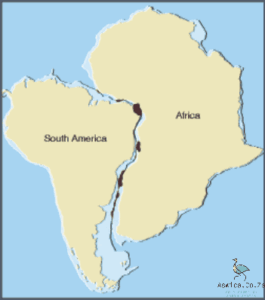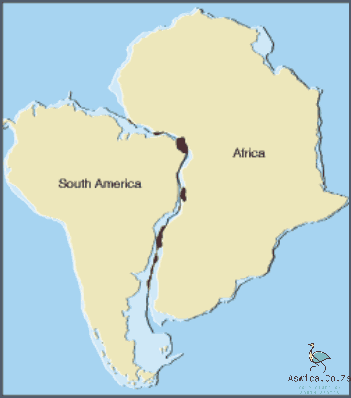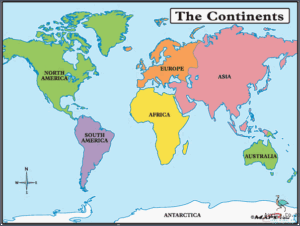
The African and South American continents are moving apart at a rate of approximately 2.5 cm/year. This is due to the divergence of the Mid-Atlantic Ridge, which is a plate boundary located between the two continents. The rate of this divergence has been relatively constant over the last few million years.
The African and South American continents are thought to have been joined together as recently as 140 million years ago. This is based on the similarity of fossils found on both continents. It is believed that the two continents began to split apart around 65-85 million years ago.
The African and South American continents are not the only landmasses that are moving apart. The Eurasian and North American continents are also moving apart at a rate of approximately 2 cm/year.
Contents
Why Africa And South America Are Moving Apart
Africa and South America have been slowly moving apart for millions of years due to a process called continental drift. This process is caused by the movement of the Earth’s tectonic plates, which are the massive pieces of the Earth’s crust. As these plates move, the continents of Africa and South America drift in different directions. This movement has been happening since the breakup of the supercontinent Pangaea, which occurred approximately 200 million years ago. Over time, the Atlantic Ocean has been created by this plate movement, separating Africa and South America. As a result, the two continents are now thousands of miles apart and continue to drift further apart each day. This process is a natural part of the planet’s geologic history and is an important factor in the unique geography of the world.
Geographical separation between Africa and South America
The geographical separation between Africa and South America is a fascinating phenomenon that has been occurring for centuries. While the two continents are often thought of as being close together, they are actually slowly drifting apart. This process, known as continental drift, is caused by the movement of tectonic plates beneath the Earth’s surface.
The tectonic plates of Africa and South America are moving in opposite directions, which is causing the two continents to drift further away from each other. This process has been occurring since the beginning of the Paleozoic era and is estimated to continue for the next several million years. This means that over time, the distance between them will continue to increase.
The separation between Africa and South America is not only seen on a geographical level, but also on a cultural level. As the two continents drift further apart, the culture and customs of each region become increasingly different. This can lead to a lack of understanding among people in different parts of the world, as well as a decrease in communication between them.
The geographical separation between Africa and South America is an interesting phenomenon that has been taking place for centuries. While it will take millions of years for the two continents to fully separate, the process is already having an impact on the cultures and customs of the regions. As they become increasingly distant from each other, it is important to recognize the importance of communication and understanding between people from different parts of the world.
Historical and cultural factors contributing to separation
The separation between Africa and South America is a complex phenomenon that has been informed by a variety of historical and cultural factors. From the slave trade to the emergence of powerful nation-states, the two continents have been moving apart for centuries, and this movement can be attributed to a number of different factors.

One of the most significant factors contributing to the separation between Africa and South America is the slave trade. During colonial times, the slave trade was a major factor in the economic and social development of the two continents. Slaves were exported from Africa to the Americas, and this had a significant impact on the cultural and economic dynamics between the two continents. The slave trade also had a major impact on the social and political relations between the two continents, creating a great deal of mistrust and hostility between them.
Another factor that has contributed to the separation between Africa and South America is the emergence of powerful nation-states in both continents. With the establishment of powerful nation-states, the two continents were less likely to interact with each other, leading to a decrease in trade and cultural exchange. This increased separation was further exacerbated by the emergence of strong cultural and religious differences between the two regions.
The colonization of Africa and South America by European powers also played an important role in their separation. With the colonization of both continents, the European powers sought to control both their economic and political systems. This led to a further decline in economic and cultural exchange between the two regions, and this decline has continued to the present day.
Finally, the political and economic instability in both continents has also played a role in their separation. In recent decades, both regions have experienced significant changes in their political and economic systems, and this has led to further instability and separation. This instability has been further exacerbated by the emergence of radical ideologies in both regions, creating further divisions between the two regions.
In conclusion, there are a variety of historical and cultural factors that have contributed to the separation between Africa and South America. From the slave trade to the emergence of powerful nation-states to the colonization of both continents by European powers, these factors have had a significant impact on the cultural, economic, and political relations between the two regions. As a result, the two continents have been slowly moving apart for centuries, and this separation is likely to continue in the future.
Economic and political differences between the two continents
Africa and South America have a long history of cultural and political ties, but that relationship is slowly changing. As globalization and economic development have progressed, the two continents have begun to drift apart both economically and politically. Here, we’ll explore the various forces that are driving this divergence and the implications this might have for the future of the two regions.
From a political perspective, the most obvious difference between Africa and South America is their respective levels of democracy. While most South American countries are democratic, Africa has long been plagued by authoritarianism and instability. This has resulted in a much weaker civil society and an inability to effectively respond to the needs of its citizens. As a result, many African countries have seen economic growth slow, while South American countries have seen significant advances.
The economic differences between the two continents are even more pronounced. While most African countries remain largely dependent on commodities and natural resources, South American countries have seen their economies diversify into areas such as finance, technology, and manufacturing. This has allowed them to gain access to markets in the West, leading to greater economic integration and greater opportunities for businesses.
The divergence between Africa and South America is also visible in the areas of foreign policy and global relations. Whereas African countries have traditionally been reliant on Western aid and support, South American countries have been able to forge their own independent paths. This has led to greater autonomy and a greater ability to pursue their own interests on the world stage.
Ultimately, the widening gap between Africa and South America is a reflection of the changing global landscape. As the two continents continue to develop, they will increasingly move in different directions. For African countries, this could mean a further decline in economic and political stability, while for South American countries, it could offer an opportunity to harness their newfound independence and continue to build their economies. Either way, it’s clear that the relationship between the two continents is changing, and the implications of this will likely be felt for years to come.
Conclusion
There are a few reasons why Africa and South America are moving apart. The first reason is that the Earth’s mantle is slowly convecting, which means that the continents are slowly drifting apart. The second reason is that the Atlantic Ocean is slowly widening as the mid-ocean ridge pushes the continents apart. The third reason is that the Pacific Ocean is slowly shrinking as the Pacific plate subducts beneath the other plates. All of these factors are causing the continents to move apart at a very slow rate.




